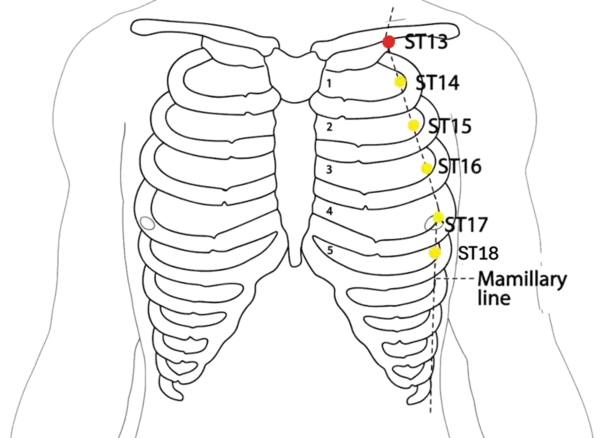ST-13 - Qi Door
气户 - Qì hù
Point Region: Chest
ST-13 Qihu, meaning 'Qi Door,' is a point that harmonizes the chest and descends Lung Qi. Located on the chest, it is a key point for addressing a wide range of issues that are caused by 'rebellious' Lung Qi, which can manifest as a cough, asthma, or a feeling of fullness in the chest. Its name, 'Qi Door,' alludes to its ability to bring a sense of order and harmony to the body's entire system.
Think of Qihu as a point that helps to 'open the door' to your lungs. It's invaluable for addressing issues like a cough, shortness of breath, and a feeling of a 'tight' chest. By harmonizing the chest and descending Lung Qi, it helps to restore a sense of ease and freedom.
By harmonizing the chest and descending Lung Qi, ST-13 helps to restore a sense of balance and inner peace. It's a point that reminds us that our true power comes from a calm and unburdened body.
Location & How to Find
Anatomical Location: On the chest, directly below ST-12, 4 cun lateral to the anterior midline, at the superior border of the first rib.
How to Locate:
- Find the hollow above your collar bone
- Move outward from the center toward your shoulder to find the deepest part
- From this deepest hollow, move straight down below your collar bone
- The point is on your upper chest in line with this hollow

Primary Functions
Respiratory System
- Treats cough and respiratory disorders
- Relieves chest congestion and tightness
- Improves lung qi circulation
- Reduces bronchial inflammation
Digestive System
- Harmonizes stomach qi in chest region
- Treats chest discomfort from digestive issues
- Relieves belching and hiccups
Musculoskeletal System
- Relieves chest and shoulder tension
- Treats intercostal muscle pain
Immune & Energy System
- Strengthens lung qi and defensive energy
- Supports respiratory immune function
Clinical Applications
Primary Indications
- Chest tightness
- Cough with reflux
- Hiccups
- Shallow breathing
- Chest pain
- Respiratory problems
- Intercostal pain
- Breathing difficulty
Related Health Concerns
Common Conditions:
Related Acupoints
Select a point to learn about its location, primary functions, clinical applications, and protocols.
ST-13 Protocols
N/A
Important Precautions
- Recent chest surgery
- Severe respiratory conditions
- Chest wall injuries